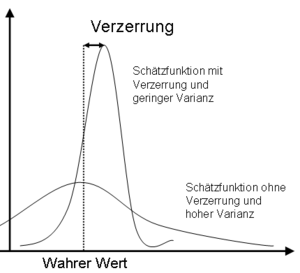- Mean squared error
-
Die mittlere quadratische Abweichung oder mittlerer quadratischer Fehler (engl. mean squared error und daher mit "MSE" abgekürzt) ist ein Begriff der mathematischen Statistik. Mit der mittleren quadratischen Abweichung kann die Abweichung eines Schätzers von dem zu schätzenden Wert (oder allgemeiner: von Funktionalen von ihnen) berechnet werden.
Inhaltsverzeichnis
Definition
Es seien
 eine Zufallsvariable und f eine messbare Funktion. Wenn g geschätzt werden soll, dann ist die mittlere quadratische Abweichung eines Schätzers
eine Zufallsvariable und f eine messbare Funktion. Wenn g geschätzt werden soll, dann ist die mittlere quadratische Abweichung eines Schätzers  für g wie folgt definiert:
für g wie folgt definiert:![\mbox{MSE}(f,g) = E [ \| f(X) - g \|^2]\;](/pictures/dewiki/97/af36cb88329fbbbfe141b81f45457c71.png)
Im klassischen Falle reellwertiger Funktionen heißt das dann:

- Dabei ist die Verzerrung
![\mbox{Bias}(f(X)) := E[f(X) - g] \;](/pictures/dewiki/97/af5cd5bebe05fd557832a5d1a4c1b46d.png) und verschwindet also im Fall der Erwartungstreue (der MSE entspricht dann der Varianz).
und verschwindet also im Fall der Erwartungstreue (der MSE entspricht dann der Varianz).
Interpretation
Eine geringe mittlere quadratische Abweichung bedeutet im klassischen Fall, dass gleichzeitig Bias und Varianz des Schätzers klein sind. Man befindet sich mit dem Schätzer also im Mittel in der Nähe des zu schätzenden Funktionals (geringer Bias) und weiß gleichzeitig, dass die Schätzwerte wenig streuen (geringe Varianz) und mit großer Wahrscheinlichkeit auch in der Nähe ihres Erwartungswerts liegen.
Mit dem MSE ist es daher möglich, Schätzverfahren miteinander zu vergleichen. Die Idee ist, dass es vorteilhaft sein kann, einen leicht verzerrten Schätzer zu bevorzugen, der dafür eine wesentlich kleinere Varianz besitzt. Dabei gilt das Schätzverfahren mit dem kleineren MSE in der Regel als das bessere.
Problematisch ist, dass der MSE vom zu schätzenden, unbekannten Grundgesamtheitsparameter abhängt.
Beispiel
Ein typischer Fall ist die Schätzung des Mittelwerts einer Normalverteilung. Wir nehmen an, dass Zufallsvariablen
 existieren, die jeweils normalverteilt mit unbekanntem Erwartungswert γ und Varianz 1 sind. Der klassische Schätzer ist das Stichprobenmittel
existieren, die jeweils normalverteilt mit unbekanntem Erwartungswert γ und Varianz 1 sind. Der klassische Schätzer ist das Stichprobenmittel  . Hier ist die Verzerrung null:
. Hier ist die Verzerrung null:da der empirische Mittelwert erwartungstreu für γ ist. Da
 selbst normalverteilt mit Erwartungswert γ und Varianz
selbst normalverteilt mit Erwartungswert γ und Varianz  ist, folgt
ist, folgtAusweitung auf beliebige Verlustfunktionen
Eine Verallgemeinerung der mittleren quadratischen Abweichung ergibt sich, wenn man in der Definition an Stelle des quadratischen Abstandes von Schätzer und unbekanntem Funktional eine beliebige andere Funktion
 ersetzt, die
ersetzt, die- symmetrisch ist,
- Werte in
 besitzt und
besitzt und - in beiden Komponenten konvex ist.
Abbildungen dieser Art heißen Verlustfunktion, das Risiko eines Schätzers
 ist dann definiert als
ist dann definiert als![\mbox{R}_\vartheta(g) = E_{\vartheta}[L(g(X), \gamma (\vartheta))].](/pictures/dewiki/101/eb06de970933dc72d68a6bb20f7257c6.png)
- Dabei ist die Verzerrung
Wikimedia Foundation.



